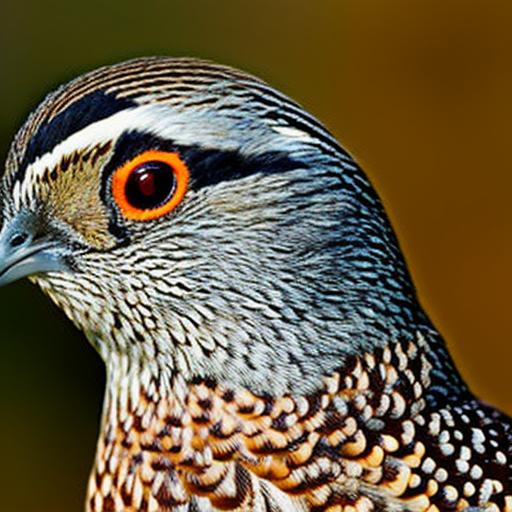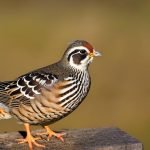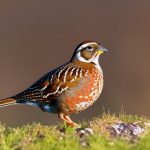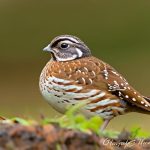The California Quail, also known as the Valley Quail, is a small, plump bird with a distinctive teardrop-shaped crest on its head. These birds are native to the western United States and are known for their sociable nature and distinctive “chi-ca-go” call. They are popular among bird enthusiasts and are often kept as pets or for hunting purposes. California Quail are ground-dwelling birds and are often found in open woodlands, brushy areas, and foothills. They are known for their adaptability and can thrive in a variety of environments, making them a popular choice for aviculture.
California Quail are known for their striking appearance, with a blue-gray plumage, a black face, and a bold chestnut patch on the belly. The males have a black throat and white stripe above the eye, while the females have a more subdued coloration. These birds are known for their social behavior and are often seen in small flocks, foraging for seeds, insects, and vegetation. They are also known for their distinctive courtship displays, which involve the males puffing up their chest and calling out to attract females. California Quail are relatively easy to care for and can make a charming addition to a backyard aviary or collection.
Key Takeaways
- California Quail are small, ground-dwelling birds native to the western United States.
- They require spacious enclosures with plenty of cover and protection from predators.
- California Quail have specific dietary needs and require a balanced diet of seeds, insects, and greens.
- Breeding California Quail requires careful management of nesting areas and monitoring of egg production.
- Regular health checks, proper handling, and care are essential for maintaining the well-being of California Quail.
Housing and Enclosure Requirements
When it comes to housing California Quail, it’s important to provide them with a spacious and secure enclosure that mimics their natural habitat. A large aviary with plenty of ground space is ideal, as these birds are ground-dwellers and require ample room to roam and forage. The enclosure should be well-protected from predators, with sturdy fencing and a secure roof to prevent escape or attacks from above. Providing natural vegetation, such as shrubs and grasses, can also help create a more naturalistic environment for the quail.
In addition to a spacious enclosure, it’s important to provide shelter and hiding spots for the quail to feel secure. This can include low shrubs, brush piles, or artificial shelters such as wooden boxes or PVC pipe structures. These birds are relatively hardy and can tolerate a range of temperatures, but it’s important to provide shade and protection from extreme weather conditions. Additionally, providing a shallow dish of water for bathing and drinking is essential for the quail’s health and well-being. Overall, creating a safe and naturalistic environment for California Quail is key to ensuring their happiness and longevity in captivity.
Feeding and Nutrition
California Quail are primarily seed-eaters in the wild, feeding on a variety of grasses, seeds, and small insects. In captivity, it’s important to provide a balanced diet that mimics their natural food sources. A high-quality game bird feed or poultry feed can serve as the base of their diet, supplemented with fresh greens, fruits, and vegetables. It’s important to provide a variety of foods to ensure they receive all the necessary nutrients for optimal health.
In addition to commercial feeds, offering grit or small stones is important for aiding in digestion, as quail do not have teeth and rely on grit to grind their food in their gizzards. It’s also important to provide access to clean water at all times, as quail can quickly become dehydrated. Additionally, offering protein-rich treats such as mealworms or crickets can be beneficial, especially during the breeding season or molting periods. Overall, providing a varied and balanced diet is essential for the health and well-being of California Quail in captivity.
Breeding and Egg Production
Breeding California Quail in captivity can be a rewarding experience for bird enthusiasts. These birds are relatively prolific breeders and can produce multiple clutches of eggs in a single breeding season. To encourage breeding behavior, it’s important to provide a suitable nesting area within the enclosure, such as a shallow depression lined with soft bedding material. The female will lay several eggs over the course of a few days, typically laying one egg per day until the clutch is complete.
Once the eggs are laid, it’s important to provide a quiet and secure environment for the female to incubate the eggs. If breeding for production purposes, it may be beneficial to remove the eggs for artificial incubation to increase hatch rates. The eggs will typically hatch after about 21 days of incubation, and the chicks will be ready to leave the nest shortly after hatching. Providing a diet high in protein and calcium is important for the health of the breeding pair and the development of strong, healthy chicks. With proper care and attention to their breeding needs, California Quail can thrive and reproduce successfully in captivity.
Health and Disease Management
Like all birds kept in captivity, California Quail are susceptible to a variety of health issues and diseases that can impact their well-being. It’s important to monitor their overall health regularly and be aware of common signs of illness, such as lethargy, loss of appetite, abnormal droppings, or respiratory issues. Providing a clean and well-maintained environment is essential for preventing disease outbreaks, as poor sanitation can lead to bacterial or parasitic infections.
Regular veterinary check-ups and preventative care can also help ensure the health of captive quail. This may include vaccinations against common avian diseases or routine parasite control measures. Additionally, providing a balanced diet, access to clean water, and opportunities for exercise can help support their overall health and immune function. Being proactive about their health care needs can help prevent potential issues and ensure the long-term well-being of California Quail in captivity.
Handling and Care

When it comes to handling California Quail, it’s important to approach them with care and gentleness. These birds are generally skittish and can be easily startled, so it’s important to move slowly and calmly when interacting with them. It’s best to avoid handling them excessively, as this can cause unnecessary stress and may lead to injuries or escape attempts.
Providing opportunities for socialization and positive interactions can help tame quail and make them more comfortable with human presence. This can include offering treats by hand or spending time near their enclosure without making sudden movements or loud noises. Building trust with the quail over time can help make them more relaxed around humans and may make handling them easier if necessary.
Overall, providing a calm and low-stress environment is key to ensuring the well-being of California Quail in captivity. By approaching them with patience and respect, it’s possible to build a trusting relationship with these charming birds.
Conclusion and Additional Tips
In conclusion, California Quail are charming and sociable birds that can make delightful additions to backyard aviaries or collections. By providing a spacious and secure enclosure, a balanced diet, proper breeding conditions, proactive health care, and gentle handling, it’s possible to ensure the well-being of these birds in captivity.
Additional tips for caring for California Quail include providing ample hiding spots within the enclosure to help them feel secure, offering opportunities for dust bathing by providing loose soil or sand, and providing perches or elevated platforms for roosting. It’s also important to monitor their behavior regularly for any signs of stress or illness and make adjustments to their care as needed.
Overall, with proper care and attention to their specific needs, California Quail can thrive in captivity and bring joy to bird enthusiasts with their charming personalities and distinctive calls.
If you’re interested in keeping California quail for eggs, you may also want to consider building a suitable coop for them. Poultry Wizard offers valuable insights on creating the perfect chicken coop in Chester, SC, with tips on design and maintenance. Check out their article on chicken coop ideas to ensure your quail have a comfortable and secure living space.
FAQs
What are California quail?
California quail, also known as Valley quail, are a species of New World quail native to the western United States. They are known for their distinctive teardrop-shaped plume on their heads and their sociable nature.
Can California quail be kept for eggs?
Yes, California quail can be kept for their eggs. They are known for laying small, speckled eggs that are considered a delicacy by some. However, their egg production is not as high as that of domesticated chicken breeds.
What do California quail eat?
California quail are omnivores and their diet consists of a variety of seeds, insects, and vegetation. In captivity, they can be fed a diet of commercial game bird feed supplemented with fresh greens and insects.
How do you keep California quail for eggs?
To keep California quail for eggs, you will need a suitable enclosure with plenty of space for the birds to roam and forage. The enclosure should also provide protection from predators and the elements. Additionally, you will need to provide a balanced diet and clean, comfortable nesting areas for the quail to lay their eggs.
Are there any legal restrictions on keeping California quail?
Before keeping California quail, it is important to check with local authorities regarding any legal restrictions or requirements. In some areas, a permit may be required to keep these birds, especially if they are being kept for commercial purposes.
Meet Walter, the feathered-friend fanatic of Florida! Nestled in the sunshine state, Walter struts through life with his feathered companions, clucking his way to happiness. With a coop that’s fancier than a five-star hotel, he’s the Don Juan of the chicken world. When he’s not teaching his hens to do the cha-cha, you’ll find him in a heated debate with his prized rooster, Sir Clucks-a-Lot. Walter’s poultry passion is no yolk; he’s the sunny-side-up guy you never knew you needed in your flock of friends!







